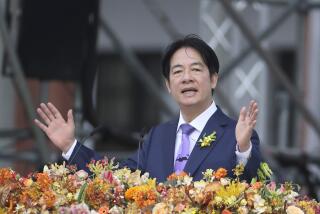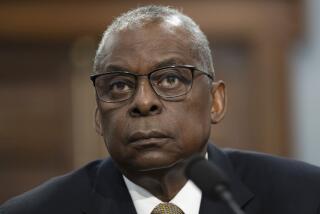South Korea-U.S. military exercises announced
- Share via
Reporting from Seoul — Joint U.S.-South Korean military exercises announced Tuesday are intended to impress on North Korea the need to change its behavior, but not allow the sinking of a South Korean warship four months ago to stymie nuclear talks, analysts said.
The naval and air exercises will begin Sunday in the Sea of Japan and include the aircraft carrier George Washington. They were announced by Secretary of Defense Robert M. Gates and South Korean Defense Minister Kim Tae-young after a meeting in Seoul.
The exercises have been in the works since the March 26 sinking of the Cheonan, which killed 46 South Korean sailors. A South Korean-led investigation concluded that the vessel was struck by a North Korean torpedo, though Pyongyang has denied involvement.
Adm. Robert F. Willard, head of U.S. Pacific Command, emphasized that the drills were the first in a series of sea and ground exercises.
The goal of the U.S.-South Korean response “is to send a very clear signal that this is not business as usual. Their behavior needs to change,” he told reporters. He added, however, that North Korea’s actions over the years raised questions about whether the secretive regime in Pyongyang will be deterred by a show of force.
The initial drills later this month will involve 20 U.S. and South Korean ships and submarines, as well as 200 aircraft, including the advanced F-22 fighter, which will be flying training missions in and around South Korea for the first time, according to a statement issued by the U.S. and South Korean militaries.
Gates emphasized the difficulty of putting effective pressure on North Korea, whose relations with the outside world often appear aimed at creating periodic crises as a way of creating leverage.
“I think this is an ongoing challenge that has to be managed over a period of years, and I think that the pressure continues to build slowly on the north,” Gates said.
At a meeting with troops, Gates said he and Secretary of State Hillary Rodham Clinton, who arrives in Seoul on Wednesday, would visit the demilitarized zone along the border with North Korea.
Analysts said the visits by Gates and Clinton were a signal to both South and North Korea.
“They want to shore up their alliance with Seoul, while reminding Pyongyang that their commitment is credible and formidable,” said Daniel Pinkston, North East Asia deputy project director for the nonprofit International Crisis Group.
Yet experts say that Washington must walk a fine line. Its goal is to bring North Korea back to the six-party talks on its nuclear program, analysts said.
“The United States wants to clinch this issue and move on, but it has to be considerate of its ally’s position,” said Chung Young-chul, a professor at Sogang University’s Graduate School of Public Policy in Seoul.
Others warn that a spurned South Korea has other military options that could further inflame tensions on the Korean peninsula. “So if Seoul gets the feeling it’s being abandoned or that its U.S. alliance is not reliable, it’s prepared do things for its own defense,” Pinkston said.
More to Read
Sign up for Essential California
The most important California stories and recommendations in your inbox every morning.
You may occasionally receive promotional content from the Los Angeles Times.















